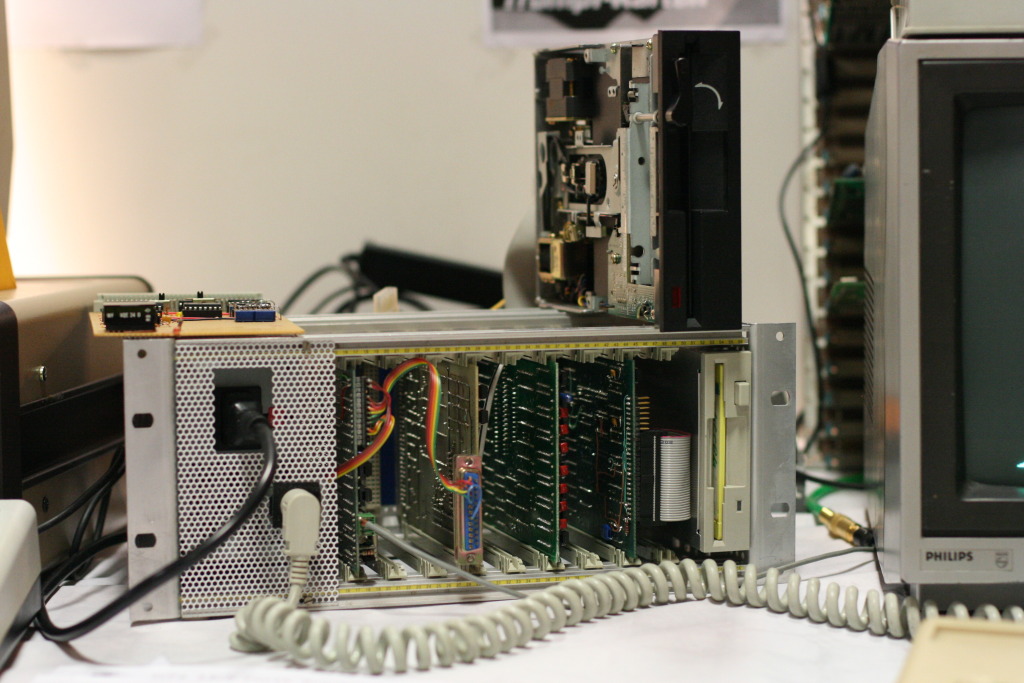Europe Card Bus on:
[Wikipedia]
[Google]
[Amazon]

 The Europe Card Bus (ECB or ECB-bus) is a
The Europe Card Bus (ECB or ECB-bus) is a
The Hardware Book - ECB-Bus
The N8VEM home brew computer project
Retrobrew Computers - current home for ECB
{{DEFAULTSORT:Europe Card Bus) Computer buses Digital electronics Motherboard

 The Europe Card Bus (ECB or ECB-bus) is a
The Europe Card Bus (ECB or ECB-bus) is a computer bus
In computer architecture, a bus (shortened form of the Latin '' omnibus'', and historically also called data highway or databus) is a communication system that transfers data between components inside a computer, or between computers. This ex ...
developed in 1977 by the company Kontron, mainly for the 8-bit Zilog Z80, Intel 8080 and Intel 8085 microprocessor families.
Physical format
Mechanically, the ECB is usually implemented as a backplane circuit board installed in a19-inch rack
A 19-inch rack is a standardized frame or enclosure for mounting multiple electronic equipment modules. Each module has a front panel that is wide. The 19 inch dimension includes the edges or "ears" that protrude from each side of the equ ...
chassis.
ECB cards have 3U Eurocard format (100 mm × 160 mm).
Connector
Use two or three-row versions of DIN 41612 connectors, 0.1" pitch. Original Kontron ECB, supported 64 pins, using "a" and "c" rows, ”b” row tied to "C' row. ECB boards are NOT compatible with STEbus or VMEbus P2 connector (while STEbus does not use the “b” column; VME does define specific signals on the ‘b’ row).Pinout
Active low signals indicated by asterisk. GND: Ground reference voltage +5V: Powers most logic. +12V; -12V: +15V; -15V Legacy power inputs, primarily useful for RS232 buffer power or ADU. The +12V used for programming voltage generators. Both can be used in analogue circuitry, but note that these are primarily power rails for digital circuitry, so decoupling or local regulation is recommended for analogue circuitry. +5VBat: Standby voltage. Optional. This line is reserved for carrying a battery backup voltage to boards that supply or consume it. NiCad batteries are common source. The ECBbus spec is not rigid about where this should be sourced from. In practice, this means that most boards requiring backup power tend to play safe and have a battery on board, often with a link to allow it to supply or accept power from +5VBat . You can end up with more batteries in your system than you need, so care must be taken that no more than one battery is driving the +5VBat line. D0...7: Data bus. This is only 8-bits wide, but most I/O or memory-mapped peripherals are byte-oriented. A0...19: Address bus. This allows up to 1 MByte of memory to be addressed. Current technology is such that processor requiring large amounts of memory has this on the processor board, so this is not a great limitation. I/O space is limited to 4K, to simplify I/O address decoding to a practical level. A 74LS688 can decode A11...4 to locate I/O slave boards at 16-byte boundaries. BUSRQ/ and BUSAK/: Bus Requests and Bus Acknowledge. Optional, used by multi-master systems. The number of Attention Requests reflects that the ECB-bus aims to be simple. Single-master systems are the norm, but these signals allow systems to have secondary bus masters if needed. HALT/: CPU Stopped. BAI 1; BAO 1: Bus Priority In; Bus Priority Out. IEI; IEO: Interrupt Enable In; Interrupt Enable Out. IORQ/: In / Out Request MREQ/: Memory Request PHI; nPHI: System Clock; nx Clock. RESET/: System Reset.Technical notes
* Signal inputs must be Schmitt trigger. * Signal outputs must have a fan-out of 20 * Backplane can have up to ?? sockets * Active bus-termination recommendedNotable uses
The DIN 41612 connector has different pin assignments assigned by various manufacturers, such as Kontron, J&K, ELZET80, Conitec, etc. N8VEM homebrew computing project uses ECB and provides a large number of various ECB cards and a couple of ECBbackplanes
A backplane (or "backplane system") is a group of electrical connectors in parallel with each other, so that each pin of each connector is linked to the same relative pin of all the other connectors, forming a computer bus. It is used as a back ...
along with Z80 processor socket shim adapters to allow a great number of retro-computers access to the ECB bus without the need for major system modification.
The Retrobrew Computer Group has expanded the definition of ECB Pinouts as well as I/O Port usage guidelines.
References
External links
The Hardware Book - ECB-Bus
The N8VEM home brew computer project
Retrobrew Computers - current home for ECB
{{DEFAULTSORT:Europe Card Bus) Computer buses Digital electronics Motherboard